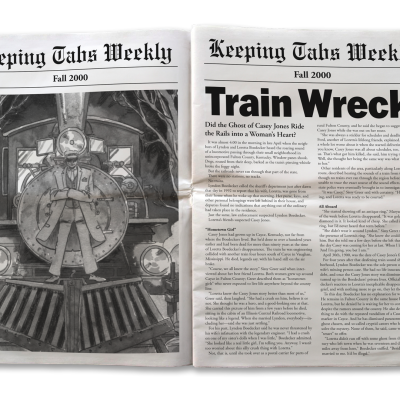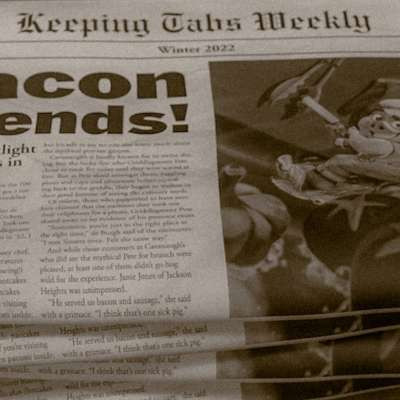70 Years Later: The Cryptid Court Case
Keeping Tabs Weekly, Winter 2019
In November 1949, Judge Emmett Cabin in Oshkosh, Wisconsin, chose to seal the records of the case Timmons v. Schneider, Case No. 49-CX-323, ordering that they be so sealed for seventy years, “at which time both parties and their immediate kin will be well beyond questioning this lunacy.”
The charges, verdict, and outcome of the case were collectively sealed. Neither the Timmons nor the Schneider families were ever publicly quoted on the matter.
Judge Cabin’s additional order that neither party discuss the case with the media, coupled with his statement at the time of sealing, led to Keeping Tabs Weekly filing a public records request with the Winnebago County Clerk of Courts’ office. What follows are select statements from Gary Timmons (plaintiff) and Milton Schneider (defendant), as well as summations from counsel, and direct quotes from the honorable Judge Emmett Cabin
● SUMMATION: Plaintiff Timmons claims that on September 20, 1949, defendant Schneider did willfully direct his goat-herding dog to wrangle the plaintiff’s own herd, resulting in the mixing of the two herds and the plaintiff sustaining injuries from said dog when attempting to reclaim his stolen property.
● COUNTERCLAIM: Defendant Schneider claims that plaintiff Timmons trespassed on defendant’s farming property, caused a dozen of the defendant’s does to stop producing milk for an extended period of time due to being terrorized, and that plaintiff Timmons did, in allowing himself to be bitten, cause defendant Schneider’s trained herding beast to flee.
Defendant notes that plaintiff’s claim is “invalid” due to the use of the word “dog,” as defendant’s herder was, in fact, a chupacabra.
● COURT ENQUIRY: “Is that a specific breed, Mr. Schneider?” “No, Your Honor, a specific monster. Kinda [sic] like a Bigfoot. But in Wisconsin. Smaller, though. And on all fours. Kinda like a dog but not.”
● PLAINTIFF’S REBUTTAL TO COUNTERCLAIM: Timmons states that Schneider’s claim of a chupacabra as his trained herder is “a dog-high pile of goat scours.”
● COURT ENQUIRY: “Mr. Timmons, what is—?” “Goat diarrhea, Your Honor.” “I see. Proceed.”
● PLAINTIFF’S REBUTTAL (continued): Additionally, Mr. Timmons asserts that he “didn’t allow myself to get bitten, Milton. You know damned good and well your herder should’ve been on a leash.” Further, Mr. Timmons asks that the record reflect that chupacabra are native to the Southwestern US and Puerto Rico. “Lessin’ [sic] you flew one in, which case you had designs on my herd from the git-go.”
● DEFENDANT’S RESPONSE TO REBUTTAL: After a series of name-calling that Mr. Schneider attributes to stress-induced Tourette syndrome and an apology in lieu of being held in contempt, Mr. Schneider states that plaintiff Timmons “is well awares that you can’t put no leash on a chupacabra unless you want three or four of your fingers bitten off.” Furthermore, Mr. Schneider strongly suggests that Mr. Timmons offer scientific testimony that chupacabra don’t travel as far as Wisconsin, “where we gots a lot of goats for them to herd.”
● COURT ENQUIRY: “Mr. Schneider, are you asking the plaintiff to provide migratory pattern research on a make-believe creature?” “No, Your Honor. On a chupacabra.”
● DEFENDANT’S RESPONSE TO REBUTTAL (continued): When defendant Schneider noted that plaintiff Timmons had not sought medical care for his alleged wound, Timmons countered by presenting the court with Exhibit A, a photograph of the bite mark. With regards to Exhibit A, defendant Schneider said, “That look like a dog bite to you, Your Honor? You got dogs, don’t you, Emmett?”
● COURT ENQUIRY: “Yes, Milton—Mr. Schneider—the court does have dogs, bird dogs mostly, and Exhibit A looks to be more like a snakebite.”
● PLANTIFF (interrupting): “That’s what a chupacabra’s bite looks like, Emmett! You know, they used to be like little vampires before they got domesticated! Besides, now, you’re letting him distract you. You think his does stopped giving milk ’causin’ I got bit by that nasty little thing? Maybe it scared them dry. And I’d ask that the court look into Milton’s mail orders and see if he had a chupacabra shipped here from Arizona. He’s got a cousin Annie who lives there—”
● DEFENDANT (interrupting): “See here, Your Honor, my cousin Annie is a respectable woman who wouldn’t be foolin’ around trying to catch a chupacabra and putting herself at risk when you can get one from a farm in Texas with almost no danger to anybody.”
● PLAINTIFF (interrupting): “Ah ha! See there! He’s a-confessing right now! He got a chupacabra from Texas, and he used it to steal my goats and cause me irrepar—irrepaira—a bunch of harm that can’t be fixed!”
● COURT (interrupting): “Okay, that’s it, boys. I’ve heard it all now. Counselors, we’re going to settle this nonsense right this minute.”
● SUMMATION: Judge Emmett Cabin ruled the following: 1) defendant should return to plaintiff all goats that came from plaintiff’s herd; 2) plaintiff should pay defendant ten (10) U.S. dollars for the defendant’s temporary loss of goat milk; 3) defendant should pay plaintiff ten (10) U.S. dollars for pain and suffering related to the wound as shown in Exhibit A; and 4) defendant should “get rid of” whatever the herder is that he’s been using to herd his goats.
● DEFENDANT (final statement): “Well, I don’t need to get rid of it. It ran away out of guilt. See, chupacabra are very sensitive creatures. It’s ashamed now and likely never to get over it.”
● PLAINTIFF (final statement): “If that’s true, well, then Milton Schneider is the one who ought to be ashamed, putting all that pressure on a poor, stupid chupacabra.”




